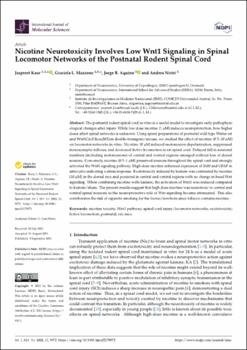| dc.contributor.author | Mazzone, Graciela. | |
| dc.contributor.author | Kaur, Jaspreet. | |
| dc.contributor.author | Aquino, Jorge. | |
| dc.contributor.author | Et al. | |
| dc.date.accessioned | 2023-10-09T13:59:27Z | |
| dc.date.available | 2023-10-09T13:59:27Z | |
| dc.date.issued | 2021-09 | |
| dc.identifier.citation | Int J Mol Sci . 2021 Sep 3;22(17):9572. | es |
| dc.identifier.issn | 1422-0067 | |
| dc.identifier.uri | https://riu.austral.edu.ar/handle/123456789/2307 | |
| dc.description | Disponible en: https://www.mdpi.com/1422-0067/22/17/9572 | es |
| dc.description.abstract | Abstract
The postnatal rodent spinal cord in-vitro is a useful model to investigate early pathophysiological changes after injury. While low dose nicotine (1 µM) induces neuroprotection, how higher doses affect spinal networks is unknown. Using spinal preparations of postnatal wild-type Wistar rat and Wnt1Cre2:Rosa26Tom double-transgenic mouse, we studied the effect of nicotine (0.5-10 µM) on locomotor networks in-vitro. Nicotine 10 µM induced motoneuron depolarization, suppressed monosynaptic reflexes, and decreased fictive locomotion in rat spinal cord. Delayed fall in neuronal numbers (including motoneurons) of central and ventral regions emerged without loss of dorsal neurons. Conversely, nicotine (0.5-1 µM) preserved neurons throughout the spinal cord and strongly activated the Wnt1 signaling pathway. High-dose nicotine enhanced expression of S100 and GFAP in astrocytes indicating a stress response. Excitotoxicity induced by kainate was contrasted by nicotine (10 µM) in the dorsal area and persisted in central and ventral regions with no change in basal Wnt signaling. When combining nicotine with kainate, the activation of Wnt1 was reduced compared to kainate/sham. The present results suggest that high dose nicotine was neurotoxic to central and ventral spinal neurons as the neuroprotective role of Wnt signaling became attenuated. This also corroborates the risk of cigarette smoking for the foetus/newborn since tobacco contains nicotine.
Keywords: Wnt1 pathway; excitotoxicity; fictive locomotion; locomotor networks; mice; nicotine toxicity; postnatal; rat; spinal cord injury. | es |
| dc.language.iso | en | es |
| dc.publisher | MDPI | es |
| dc.rights | Attribution-NonCommercial-NoDerivatives 4.0 Internacional | * |
| dc.rights.uri | http://creativecommons.org/licenses/by-nc-nd/4.0/ | * |
| dc.subject | Wnt1 pathway | es |
| dc.subject | Excitotoxicity | es |
| dc.subject | Fictive locomotion | es |
| dc.title | Nicotine Neurotoxicity Involves Low Wnt1 Signaling in Spinal Locomotor Networks of the Postnatal Rodent Spinal Cord | es |
| dc.type | Article | es |


